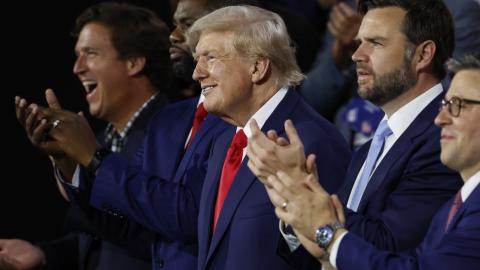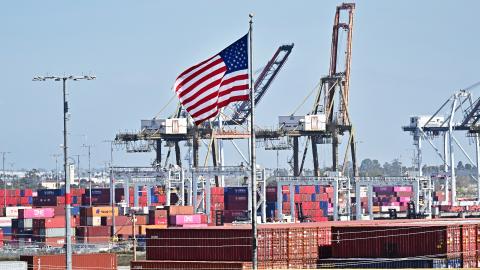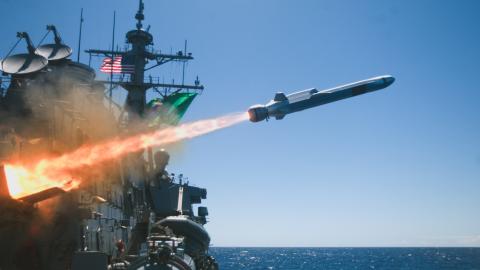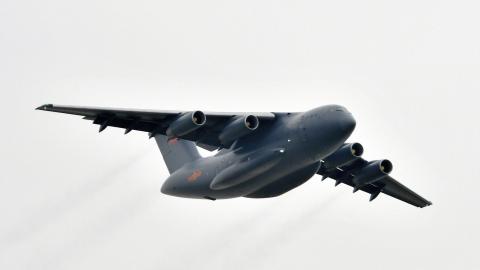Donald Trump’s inauguration as the forty-seventh president of the United States marks the beginning of a new era of superpower competition.
Last week, Washington experienced a fleeting sense of normalcy with Senate confirmation hearings and President Joe Biden’s farewell address. Even the theatrics of Secretary of Defense nominee Pete Hegseth’s hearing and Biden’s warnings of a “tech-industrial complex” seemed restrained compared to the political storm that is expected to follow Trump’s inauguration at noon on Monday.
In his second inaugural address and through a series of executive orders, President Trump will unequivocally assert that U.S.A., Inc. is under new management.
Monday also signals the start of what Beijing once described as a “new type of great power relations.” Although this may be round two of the Trump-Xi matchup, there is no doubt that the two leaders’ ice-breaking phone call last Friday represented the opening jockeying for strategic advantage between the two most powerful men in the world.
Xi Jinping telephoned, shortly after official Chinese data showed Beijing had met its 5 percent GDP growth target for 2024, to let President Trump know he was giving him face by dispatching Vice President Han Zheng to attend the inauguration. Xi has been busily preparing potential retaliatory moves in the event of further tariffs and export controls. Yet, the phone call intended to get ahead of the curve of what is sure to be lively debates between competing camps within the Trump administration.
Indo-Pacific observers are watching how the tug-of-war between “peace-through-strength” defense hawks and advocates of Big Tech and trade engagement will unfold.
China is “the most potent and dangerous near-peer adversary this nation has ever confronted,” Secretary of State nominee Marco Rubio asserted in his confirmation hearing. Rubio blamed China for lying, hacking, and cheating its way to superpower status. He emphasized the urgent need to clear the backlog of arms sales to Taiwan and reduce America’s dependence on China.
Incoming National Security Advisor Michael Waltz underscored bipartisan support for countering China during the U.S. Institute of Peace’s “Passing the Baton” event, a quadrennial handoff I helped to initiate as USIP Director of Studies in 2001. Waltz commended the Biden administration’s strategic cooperation with Indo-Pacific allies through minilateral initiatives like AUKUS, the Quad, and trilateral agreements involving the United States, Japan, South Korea, and the Philippines. These partnerships provide a foundation for navigating the likely turbulence ahead.
However, these traditional strong-defense views are not the only deeply-held convictions within the new administration. A host of economic and defense challenges awaits, ranging from the rescue of TikTok to the looming threat of Taiwan’s forced unification with China, and a number of key officials are laser-focused on prosperity. Emblematic of this perspective was Treasury Secretary nominee Scott Bessent’s call for a “new economic golden age.” His “3-3-3” plan prioritizes energy dominance, GDP growth, and fiscal management. Proposed measures include cutting taxes, deregulating supply chains, encouraging new investments, leveraging tariffs, and negotiating more favorable trade deals, including with China.
Of course, President Trump sits atop a cohort of senior officials with diverse views. Both hardliners and pragmatists hope to emulate Sun Tzu and “win without fighting.” At least, as Senator Rubio acknowledged in his own confirmation, President Trump believes that conflict with China can be avoided; negotiation from strength is the key.
The newfound influence of Big Tech CEOs in the Trump administration is a reminder of the innovative and industrial clout of the private sector. Amid intensifying competition with China, companies have not been sitting idly by during the Biden administration. For example, Apple’s decision to move some operations to India reflects a trend toward reducing dependence on China, just as China’s decision to impede that move suggests that Beijing is in no hurry to see offshoring. Meanwhile, others fear Trump tariff enforcement will follow friendshoring. Singapore’s former ambassador to the United States, Chan Heng Chee, has warned that Southeast Asian countries like Singapore could become “collateral damage” if the U.S. enforces strict trade protections.
The new administration’s immediate agenda is ambitious. It includes ending the war in Ukraine, reshaping the Middle East, and potentially holding another meeting with North Korea’s Kim Jong-un. However, an anticipated meeting between Trump and Chinese president Xi Jinping later this year will serve as a defining moment in this new era of superpower competition. Events leading up to this summit will shape the strategic landscape.
Key economic challenges include negotiating a deal to save TikTok, even as “refugees” flee to Chinese apps like Xiaohongshu (literally “Little Red Book” or RedNote). Bilateral economic relations hinge on clarity regarding trade and technology policies, such as the “small yard, high fence” approach articulated by the previous administration. Strategic concerns like semiconductor chip controls and data security will dominate discussions in the months ahead. However, export controls alone are unlikely to outpace China’s progress, much like how eighteenth-century France was unable to prevent England’s industrial revolution.
For Trump, the pressing question is how to approach a second trade deal. China’s two-speed economy is marked by slow consumption and construction but fast industrial production and exports. Xi has been preparing to counter tariffs with Beijing’s playbook of restrictions on critical minerals, regulations, and self-sufficiency measures. But in many ways, the specifics of a deal are less important than the overall competition over the rules of the road writ large.
David Rennie of The Economist offers insight into China’s ambitions. Having spent the past six years in the country, Rennie observes that China seeks to revise the U.S.-led post-World War II order, positioning itself as a defender of the status quo against “America First” policies. China’s Xi aims to replace universal democratic values with “universal security,” promoting a world order conducive to techno-authoritarianism—a point echoed by Biden’s warning about a “tech-industrial complex” in his farewell address.
Economic interdependence constrains both nations. Trump risks a backlash from tariffs. Xi relies on advanced markets to support China’s export-driven strategy while striving for self-reliance.
The competition will intensify in the Global South, especially among BRICS nations. China has expanded its influence beyond Asia to Africa and Latin America. Xi recently gifted Sri Lankan president Anura Kumara Dissanayake a $3.7 billion state-of-the-art oil refinery adjacent to the Hambantota Port, itself a product of Belt and Road Initiative largesse. Xi also recently engaged with Vietnam’s general secretary as Russia promoted Vietnam’s inclusion in BRICS. Both of these and many other moves by Xi Jinping suggest China hopes to outflank the Trump pressure campaign by forging new ties in emerging markets.
China is also strengthening ties with Europe and advanced Asian economies. If President Trump’s gambit to buy Greenland appears to bully America’s allies and partners, China is prepared to swoop in and exploit such tensions. As Chinese scholar Wang Jisi warns, “Now it’s America’s turn to make mistakes.”
The agenda on defense and security competition is even more fraught with tension. Under Trump, the U.S. defense industrial base and armed forces will face a fundamental transformation and focus on strategic outcomes rather than social experimentation. A true pivot to Asia appears likely, requiring greater cost-sharing with allies and expanded cooperative efforts in space, global chokepoints, and cyberspace.
However, the region’s primary defense flashpoints—Taiwan and the South China Sea—are ripe for confrontation. Taiwan faces mounting psychological pressure with revelations of China’s military modernization and narrative warfare. For instance, China’s ambassador to Australia accused Taiwanese vice president Lai Ching-te of pursuing independence, making it clear psychological pressure will only mount on Taiwan in the months ahead. At the same time, China’s revelations of new portable bridge docks and large Type 076 amphibious platforms capable of integrating uncrewed systems suggest steady progress toward invasion capabilities.
The South China Sea will also see more roiled waters. The Philippines has complained that China’s escalating gray-zone operations, such as deploying massive coast guard vessels to challenge its territorial claims, are pushing Manila “to the wall.”
This superpower contest will likely involve simultaneous conflicts and growing cooperation among revisionist powers like China, Russia, North Korea, and Iran. As John Ratcliffe said during his confirmation hearing to become director of the CIA, the “increasing coordination among America’s rivals” constitutes as grave a security challenge as the United States has ever faced. Contingency planning will become increasingly complex.
President Trump prioritized China during his first term. Eight years later, a new era of superpower competition has arrived. The only question now is the course it will follow.




















